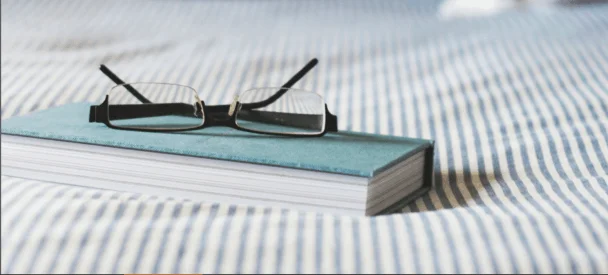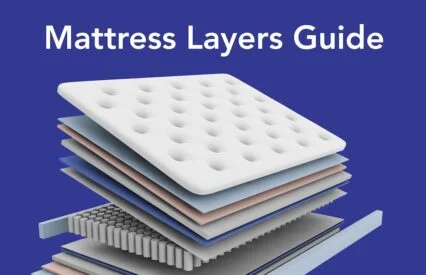You’ve probably heard people use duvet and comforter interchangeably, and while they share many similarities, there are a handful of significant differences between the two. A duvet typically comes as two parts, an insert and a cover, whereas a comforter combines everything into a single piece of bedding.
In this guide, I’ll break down the main differences in detail, from construction and sizing to ease of care and overall feel. I’ll also share some guidance on when it makes sense to choose one over the other to give you a clear idea of which option is the best fit for your bedroom.
Duvet vs Comforter: Video Comparison
For a crash course on how a comforter is different from a duvet, watch our expert mattress testers break down the differences between these two sleep essentials in our video comparison.
The Key Difference Between Duvets and Comforters
Your sheets and pillows provide the foundation for comfort, but it’s the duvet or comforter that delivers the warmth you rely on at night. A duvet offers versatility with its removable cover, while a comforter provides a ready-to-use solution. No matter which you choose, both are essential in shaping the comfort and overall style of your bed.
Both contain either natural or synthetic fibers, including cotton, polyester, wool, or down feathers on the inside.
The most significant difference between the two is that while a comforter is a stand-alone product, a duvet contains two separate pieces: the insert and the cover.
Most of the time, when people hear the word “duvet,” they immediately think of the removable cover. You may also hear the words “duvet insert” and “fill” used interchangeably. Oftentimes, the duvet cover and the duvet insert are sold separately.
Similar to how you would put a pillow inside a pillowcase, the duvet insert fits snugly inside the duvet cover. A comforter does not have a separate cover. It is a stand-alone piece of bedding.
What Is a Duvet?
A duvet is a type of blanket designed to provide warmth and comfort, similar to a comforter. The key distinction between a duvet and a comforter is that you typically pair a duvet with a separate cover. Traditionally, duvet inserts were filled with down (the soft feathers found on waterfowl) for their warmth and loft. However, you can find many alternatives today that use down alternative, wool, or cotton fills.
Duvets are essentially large fabric pockets stitched into squares or patterns to prevent the fill from shifting. The insert is inside a duvet cover, which fastens with ties, buttons, or zippers, holding everything in place. While putting on the cover can be a bit tricky, it provides valuable protection against dirt and wear. The cover also allows you to change the look of your bedding.

Historically, duvets gained popularity for their exceptional ability to keep you warm, though their steep price and limited durability made them a luxury item. Over time, duvets became increasingly accessible and eventually rose to prominence across Europe in the late 20th century. Today, duvets are widely available worldwide and remain a staple in both minimalist and luxury bedding setups.
Duvet Care
When it comes to cleaning your duvet, you only have to wash or dry-clean the duvet insert once or twice a year. Since the cover takes most of the wear and tear of daily use, you can easily remove it and wash it according to its care instructions.
Duvet and duvet cover care requirements typically depend on the materials. For example, some inserts are machine-washable in large-capacity machines, while others may require professional dry cleaning.
Duvet Pricing
Duvets can be more expensive than comforters, especially if filled with premium down. That said, the ability to replace just the cover instead of the entire insert can make them a smarter long-term investment. You can also purchase thinner duvet inserts for warmer seasons and swap them out accordingly while using the same cover.
What Is a Comforter?
A comforter is a type of bedding made by stitching together two layers of fabric (commonly cotton or a cotton blend) and filling the interior with insulating materials such as down, down alternative, cotton, or wool. Similar to a duvet, the stitching is done in a quilted pattern to prevent clumping over time.
A comforter is a standalone product, meaning you don’t need to buy a separate cover to protect it. Many comforters come pre-styled with colors, patterns, or textures that add a decorative focal point to your bed. Because they don’t require an additional cover, comforters tend to be more convenient for sleepers who want a ready-to-use option straight out of the package.

Comforter Care
Caring for a comforter can vary depending on its size and fill. While some are machine-washable, many are too bulky for standard washers and dryers, meaning you will have to take them to a laundromat with an industrial-sized washer and dryer or have them professionally cleaned to preserve their quality.
Comforter Pricing
Since comforters are sold as one piece, they are generally cheaper than duvets. However, prices also range widely based on fabric, fill, and craftsmanship. For budget-conscious shoppers, buying a comforter as part of a bedding set can be a cost-effective option (and it makes it easier to color-coordinate sheets and other bedroom accessories).
Duvet vs. Comforter: Pros and Cons
Duvet Pros and Cons
| Pros | Cons |
| Shopper can mix and match bedding options | May not match exactly with your bedroom set |
| Increased longevity of duvet insert | Changing duvet insert can be complicated |
| Easier to wash and clean | Fill inside may bunch |
| Breathable fill materials for hot sleepers | Duvets are typically more expensive |
Duvets are ideal for sleepers who prefer the option to mix and match their bedding. Duvets are also a good option for people who like to change the look and feel of their space throughout the year.
Since you can change the insert and cover, you can likely get more longevity out of a duvet, as both the cover and the insert are easily replaceable. Washing duvets and duvet covers and storing them is a breeze since they are less bulky compared to comforters.
Some people with duvets also choose to sleep without a top sheet, or “European style.” Bedding brands often substitute top sheets for duvet covers in certain sets. That said, brands sell duvet covers and inserts separately, which typically makes it more expensive than a complete comforter bundle.
If you’ve never placed a duvet insert in a duvet cover, it can be time-consuming, and it can take some practice before you nail it down. When placing the insert inside the duvet cover, ensure that the fill is evenly distributed.
If you’re set on buying a new duvet, head over to our list of the best duvet covers to get some ideas.
Comforter Pros and Cons
| Pros | Cons |
| Convenient to purchase just one item | May be more difficult to wash at home |
| Usually more affordable | Not as suitable for hot sleepers |
| Easier to layer | Less stylistic flexibility |
| Consistent fill and feel | Limited customization |
Comforters are ideal for sleepers seeking a streamlined shopping experience. They often come in comforter sets that also feature a top sheet, fitted sheets, pillowcases, and other bedding accessories, which is great for those who don’t want to spend time matching different bedding accessories and patterns. This option is also suitable for those looking for a “catalog” bedroom aesthetic.
For these reasons, buying a comforter can be a more affordable option. Additionally, comforters tend to have a consistent fill throughout and are easy to layer with other bedding accessories.
On the other hand, some sleepers may appreciate the versatility offered by changing the insert of a duvet to a different material. This detail can come in handy for hot sleepers, who may prefer a lighter fill in cooler months.
However, comforters are cumbersome and can be difficult to wash at home, which can present a problem in some living situations.
If you’re sold on buying a new comforter, then I suggest you check out our picks of the best comforters to help you in your search.
What Size Should You Buy?
Mattress sizes range from twin to California King. Luckily, duvets and comforters are available in all sizes, so it will be a breeze to find one that matches your desired look and fits your mattress.

What Else Should You Consider When Buying a Duvet or Comforter?
Beyond coziness and comfort, a few details can influence the comforter or duvet you choose. Considering materials, price, and style can help you narrow down your options.
Materials
The materials used in a duvet or comforter directly affect comfort, breathability, and longevity. Sleepers who tend to feel chilly at night would benefit most from insulating fabrics like fleece, flannel, microfiber, or cotton sateen.

On the other hand, hot sleepers often gravitate toward breathable options like Tencel, bamboo, or cotton percale. If you have sensitive skin, you may also want to prioritize hypoallergenic textiles and fills that minimize irritation.
Fill
The fill of a duvet or comforter is what gives it loft, warmth, and overall feel. Options range from polyester to natural down, each with distinct pros and cons. The amount of fill also determines whether your bedding feels light and airy or dense and cozy.
For example, down is prized for its lightweight insulation but comes at a higher price point, while down alternatives are usually more affordable and easier to maintain.
Allergies
If you have allergies or asthma, you need to be selective about your bedding. Natural down can sometimes trap dust or cause reactions in sleepers with allergies or sensitive skin. In that case, a hypoallergenic down-alternative fill may be a safer choice.
Additionally, most duvet covers are removable and easy to wash, making it much easier to keep allergens at bay.
Price
Cost varies widely depending on the materials, fill, and brand. Real down products are typically more expensive than down alternatives, and natural fabrics tend to be more expensive than synthetics.
Still, it’s worth considering trial periods, return policies, and warranties before making a purchase. A company that offers generous policies is signaling confidence in its product, which can give you peace of mind as you invest in your bedding.
Duvet vs. Comforter FAQs
Which is better, a duvet or a comforter?
Neither option is objectively better. The better option for you depends on your personal preferences and lifestyle. Duvets offer versatility since you can change covers, while comforters are ready to use without extra pieces. The best choice depends on how much maintenance and flexibility you want in your bedding.
What are the disadvantages of a duvet?
Duvets can be tricky to assemble since getting the insert into the cover isn’t always easy. The insert may also shift inside the cover if it isn’t properly secured, which means occasional fluffing and adjustment.
Why do people get duvets instead of comforters?
Many people choose duvets for their versatility; you can swap out the cover to change the look of your bed without buying a new insert. They’re also easier to keep clean since you wash the cover more frequently than the insert.
How often should you wash a duvet?
If you use a duvet cover, the insert itself only needs to be washed about once or twice a year. The cover should be cleaned much more frequently (typically every one to two weeks) along with your sheets.
Are duvets good for hot sleepers?
Yes, duvets can work well for hot sleepers if you choose the correct fill. Lightweight or down-alternative duvets offer breathability and temperature regulation, making them more comfortable than heavier options.
What is the best duvet filling?
The best fill depends on your needs. Down feathers are prized for their warmth and loft, while down alternative offers a hypoallergenic and more affordable option. Wool and cotton fills are also excellent for breathability and temperature control.
Sources
- Almost 300 years without a duvet. (2015, December 25). BBC News. https://www.bbc.com/news/magazine-34848546































